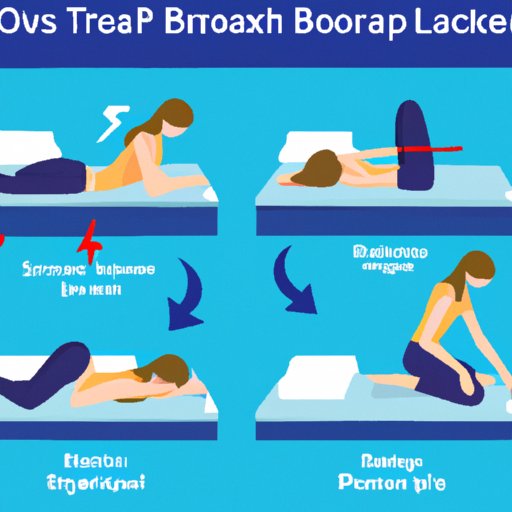
I. Introduction
Lower back pain while sleeping is a common problem that affects millions of people worldwide. It can disrupt sleep quality, causing daytime fatigue, irritability, and poor concentration. If you suffer from lower back pain, addressing the issue is crucial for your overall health and well-being. In this article, we’ll explore some effective tips and tricks on how to sleep better when you have lower back pain.
II. Use a Suitable Mattress
Choosing a suitable mattress is crucial in supporting the lower back when you sleep. A good mattress should promote proper spinal alignment, reduce pressure points, and offer adequate support.
When choosing a mattress, look for one that is medium-firm. Such a mattress will provide sufficient support while cushioning your body. Also, consider investing in an adjustable mattress with a support system that supports the natural shape of your spine.
III. Take a Warm Shower Before Bedtime
A warm shower before bedtime can promote relaxation and ease tension in the lower back. Warm water helps to increase blood flow, reducing pain and stiffness. A warm shower before bedtime can also improve sleep quality, making it easier to fall asleep and stay asleep.
To maximize the benefits of a warm shower, ensure that the water temperature is around 40-43°C (104-109°F). Take your time under the showerhead, focusing on massaging your lower back gently.
IV. Support Your Knees
Supporting your knees while sleeping can help reduce pressure on your lower back. It aligns your spine correctly, which can help relax your muscles and reduce pain. For back sleepers, placing a pillow under your knees can help support your lower back and reduce strain.
For side sleepers, placing a pillow between your legs can help maintain proper spinal alignment. This will reduce stress on your lower back, hips and pelvis. A good pillow for this purpose should be firm and supportive.
V. Try Some Gentle Yoga Poses
Yoga has been shown to be an effective way of reducing lower back pain and promoting relaxation. Certain yoga poses can help stretch and mobilize your lower back muscles, promoting better sleep. Some of the best yoga poses for lower back pain include:
- Cat-Cow Pose
- Child’s Pose
- Happy Baby Pose
You can practice these poses before bedtime to help you sleep better. Ensure that you take your time, breathe deeply and move gently into each pose without straining your muscles.
VI. Use Heat Therapy
Heat therapy is an effective way of relaxing muscles in the lower back and reducing pain. Applying heat improves blood circulation, which reduces inflammation and swelling.
There are several options when it comes to heat therapy. You can use a heat pad, hot water bottle or even a warm towel to apply heat to your lower back. Ensure that you use heat safely and avoid sleeping with a heating pad, as this can increase the risk of injury.
VII. Practice Good Sleep Habits
Creating a comfortable sleep environment is crucial in promoting better sleep quality. Ensure that your bedroom is cool, quiet and dark. Avoid using electronics before bedtime, as this can interfere with your sleep quality. Also, establish a consistent bedtime routine to help your body prepare for sleep.
Avoid consuming caffeine or stimulants before bedtime, as this can interfere with your ability to sleep. Instead, consider drinking herbal tea such as chamomile, which is known for its calming effect.
VIII. Consider Seeking Professional Help
If your lower back pain persists despite trying the above tips, consider seeking medical intervention. A doctor or physical therapist can evaluate your condition and recommend additional treatment options such as medications or physical therapy.
Other options such as massage therapy or chiropractic care may also be helpful in managing your lower back pain. However, it’s essential to seek treatment from a licensed practitioner to avoid further injuries.
IX. Conclusion
Sleeping with lower back pain can be a frustrating experience, disrupting your overall well-being. However, by following the above tips and tricks, you can sleep better and alleviate your lower back pain. Remember to take your time and listen to your body, and seek medical intervention if your symptoms persist. A good night’s sleep leads to a healthier and happier lifestyle.





